A month ago I asked people for information about 9 relatively unknown or isolated cable systems around the world. Marielle Brown offered to write a guest post about the troubled Maokong Gondola in Taipei and I was more than happy to accept.
The Maokong Gondola originally opened in July 2007, but was closed shortly after in October 2008 due to safety concerns after a typhoon left one of the support pillars damaged near a cliff. After relocating the pillar, and extensive safety testing, the Maokong Gondola reopened in April 2010.
The system is 4 km long, with 6 stations (four for passengers and two for turns). It has a vertical climb of 275.2 meters, 25 piers and 47 towers. Built by Poma, it has 147 TC 8 cars, with a maximum speed of 6 m/s and a reported 2400 pphpd capacity. When it first opened, it reportedly cost US$39.3 million, making it about US$10 million per kilometer.
Maokong is a tourist area on a forested hill outside of Taipei, with a zoo, several temples and beautiful views. Prior to the gondola, it could only be accessed by bus or car on narrow, windy roads through the hills. The gondola takes about 25 minutes, longer than the bus (my cousin and I “raced” using the different modes). However, if all of the gondola users had been in cars or buses, there probably would have been significant congestion on the small roads of Maokong.
The station is a few hundred meters from the end of a metro line, past an activity center for children. The Taipei transit Easycard can be used for the system, and the fare ranges from 30-50 Taiwanese Dollars depending on the distance travelled. Most of the metro rides I took were under $35 (apx. US$1.25), while the buses were $15-$25.
The system is primarily built for local tourism purposes; short trips by local residents. Students from Taipei elementary schools currently ride for free, while their accompanying adults ride half price. I rode the system on a Sunday, and it seemed like most of the riders were families buying discounted tickets from staff, rather than using the ticket machines or their Easycards. Though it was crowded, it only took a few minutes to work through the line, since cars came so frequently.
The staff did not, however, fill the cars to capacity, but instead let every group have their own car. My cousin and I were thrilled with our private car, until we got to the second station and saw that they did it in order to be able to add more groups later down the line.
Gondola rides were free on the reopening day, though limited to 10,000 rides. The system opened at 9 am, and the free rides were used up by 3 pm.
The views from the gondola are amazing. The cars brush just over the treetops, and the cable soared over a large ravine. The cars are painted with cartoon animals, as a tie-in with the zoo. The entire route is through forested hills and the gondola system was built with a good deal of manual labor in order to protect the environment. The Taipei Rapid Transit Corporation (TRTC) website claims that workers carried loads of up to 60 kg to the site, and that a good deal of the digging was done by workers, not machines.
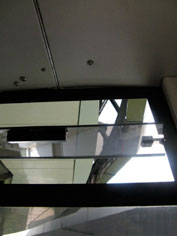
New windows in the Maokong Gondolas have helped somewhat, but high temperatures are still a problem that need to be addressed.
The views truly are the best part of the ride. The cars did, however, bounce slightly as they went over towers, and they swayed too much to stand up in (making it very hard to take pictures). When the system first opened with Ariana cars, it was criticised for lack of ventilation. Now there are slats on the top of the windows, and the Poma web site lists the cars as TC 8s. Despite these changes, the vehicles are still hot and uncomfortable. Over the thirty minute ride, all of the adults in my car acquired several new and awkward sweat stains.
The very mild breeze may be perfect the rest of the year, but I don’t recommend taking a ride in the summer.
The two turning stations are fairly slim in profile. Turning Station One does not employ a bull wheel – instead, the cars detach from the cable, are guided through the turn, and then reattached to the cable, similar to a passenger station. I did not witness a bull wheel at Turning Station Two, though the TRTC website claims that there is one. The station is quite slim, and it completes a 80.3 degree turn. In the photo, there is a large structure on the right side, but it appeared to be a maintenance facility, and was not actually involved in the turn.
When the system was first opened, it was criticised for lack of ventilation and safety concerns. Mayor Hau Lung-bin was stuck in a car for about ten minutes due to a faulty door latch on the opening day. Taipei safety concerns include lightning, typhoons, strong rain, and earthquakes; the operators claim to shut down the gondola as soon as any of these are even slightly threatened. According to the tourist brochure, the safety precautions include a tower-mounted prism and laser distance rangefinder. It also has all of the less glamourous standard safety precautions like a backup engine and location detectors. The brochure boasts that the gondola at one point had the highest level of availability for any Poma system, 99.51% over one year.
Several Democratic Progessive Party city councilors have criticised the current reopening for having low safety standards. Given its poor track record and its status as tourist-oriented transit, the system has drawn a great deal of controversy and it seems that you need a strong background in Taipei’s politics to parse all of the claims and counter claims.
Though the TRTC boasts of the gondola’s environmental standards, the construction process and increased noise and trash have also been criticised by local environmental groups.
It will be interesting to see how public opinion and use evolve. Hopefully this time around the gondola is as safe and reliable as TRTC claims. It was certainly an enjoyable way to visit the Maokong area.
Riding the system reminded me that not all trips are work related. Transit planning needs to address all trips, and a system is no less serious if its peak hours occur all day two days a week rather than for a few hours five days a week.
If you’d like to learn more about the Makong Gondola, follow these links:
- http://www.skyscrapercity.com/showthread.php?t=438398
- http://www.chinapost.com.tw/taiwan/local/taipei/2010/05/03/254867/TRTC-blasted.htm
- http://www.chinapost.com.tw/taiwan/local/taipei/2010/03/03/246611/Maokong-Gondola.htm
- http://www.poma.net/en/project/index/view/id/8
- http://www.taipeitimes.com/News/taiwan/archives/2007/07/05/2003368158
- http://gondola.trtc.com.tw/eng/index.htm
- http://www.taiwanderful.net/guides/maokong-gondola
- http://www.chinapost.com.tw/taiwan/local/taipei/2010/03/24/249566/Maokong-Gondola.htm
- http://www.taipeitimes.com/News/feat/archives/2008/06/19/2003415078

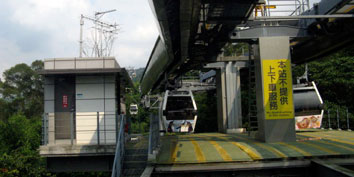
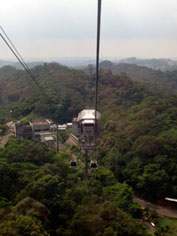
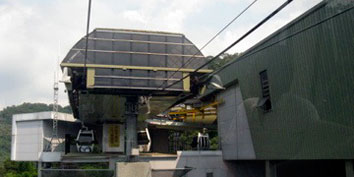
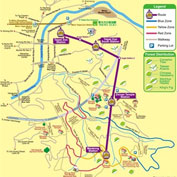
2 Comments
I hope Transit Planning/Planners do remember that all trips need not be work related. School outings and family time are very, very important. Where will tomorrow’s planners come from, and how much better can today’s be, if they are allowed family and school time with their children. Incorporating their work with real outings. Thank you.